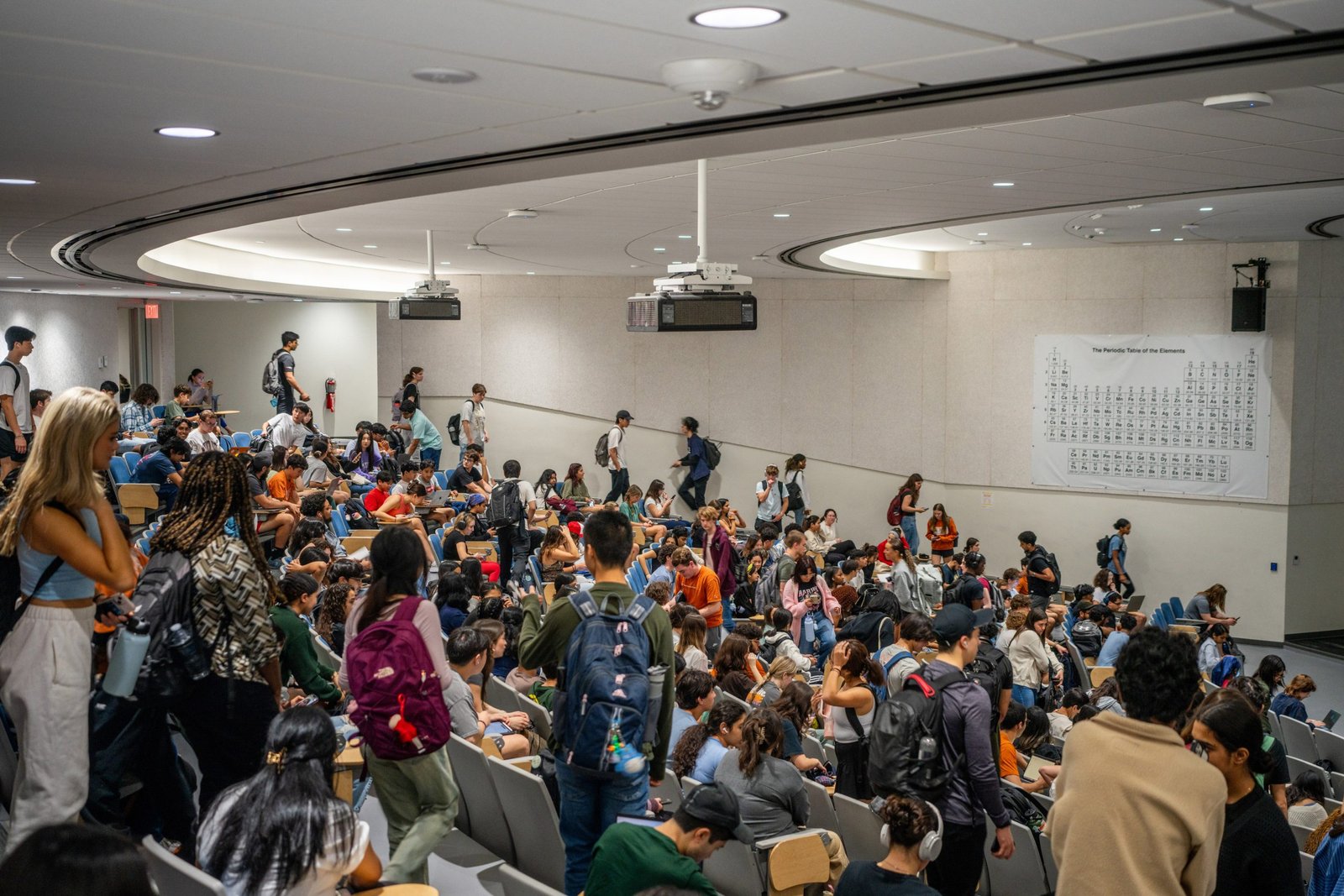Ryan Arnoldy started community college with the goal of eventually transferring to a four-year university and getting a degree in chemical engineering.
Soon Arnoldy started running up against the same exasperating bottleneck faced by a majority of university and college students: Classes required for his major were often not taught during the semesters he needed them, or filled so quickly there were no seats left.
Colleges and universities manage to provide these required courses when their students need to take them only about 15 percent of the time, new research shows — a major reason fewer than half of students graduate on time, raising the amount it costs and time it takes to get degrees.
Now, with widespread layoffs and budget cuts on campuses, and as consumers are already increasingly questioning the value of a college education, the problem is expected to get worse.
“What is more foundational to what we do as colleges and universities than offering courses to students so they can graduate? And yet we’re only doing it right 15 percent of the time,” said Tom Shaver, founder and CEO of Ad Astra, a company that provides scheduling software to 550 universities and whose research is the basis for that statistic.
Three years into his time at Johnson County Community College in Overland Park, Kansas, Arnoldy has completed so few required credits that he changed his major to computer science, almost lost his financial aid, considered dropping out and wasted time in classes he found irrelevant but were the only ones available.
And he still has at least a year to go.
Though he’s determined to finish, and has narrowly held onto enough scholarships and grants to stay in school, being shut out of courses he needed to graduate means “I am going to literally spend four years in a community college to get a two-year degree,” said Arnoldy, who is 21.
At one point, when he went to his counselor’s office for help with this, he remembered, “I was bawling. It seems like things should be simpler. A lot of my peers are frustrated, too.”
This kind of experience is, in fact, widespread. Fifty-seven percent of students at all levels of higher education end up having to spend more time and money on college because their campuses don’t offer required courses when they need them, according to a study last year by Ad Astra.
Though its scheduling work means the company has a vested interest in highlighting this problem, independent scholars and university administrators generally confirm the finding.
“We’re forcing students to literally decelerate their progress to degrees, by telling them to do something they can’t actually do,” Shaver said.
Related: Interested in innovations in higher education? Subscribe to our free biweekly higher education newsletter.
Scheduling university and college courses is complex. Yet rather than use advanced technology to do it, some institutions still rely on “old-school” methods that include producing hard-copy spreadsheets, according to administrators trying to address the issue.
Mounting layoffs and budget problems in the wake of enrollment declines and federal spending cuts threaten to make this problem worse.
Colleges and universities have collectively laid off thousands of faculty and staff in the last six months, with more downsizing expected. Others are further trimming their number of courses.
The cash-strapped California State University system has eliminated 1,430 course sections this year, across seven of its 23 campuses, or 7 percent of the total at those campuses, a spokeswoman, Amy Bentley-Smith, confirmed. These include sections of required courses. At Cal State Los Angeles, for example, the number of sections of a required Introduction to American Government course has been reduced from 14 to nine.
“I would expect that course shutouts will start to get worse,” said Kevin Mumford, director of the Purdue University Research Center in Economics, who has also studied this.
In addition to taking longer and spending more to graduate, students who are shut out of required courses often change their majors, as Arnoldy did, or drop out, Mumford’s and other research has concluded.
Together with economists at Brigham Young University, Mumford found that when first-year students at Purdue couldn’t get into a required course, they were 35 percentage points less likely to ever take it and 25 percentage points less likely to enroll in any other course in the same subject.
The students were part of a freshman class in 2018 that was 7 percent larger than expected, and more than half could not get into at least one of their top six requested courses.
Many changed their majors — especially away from science, technology, engineering or math, often abbreviated STEM. Every required STEM course a student couldn’t get into lowered the probability that he or she would major in one of those fields, according to the study, which was released in May.
Women, already underrepresented in STEM, were particularly likely to quit, the study found.
“There’s already a lot of pressure on women in STEM fields, and this appears to be just one obstacle too many,” Mumford said.
Related: The Hechinger Report’s Tuition Tracker helps reveal the real cost of college
For every course they couldn’t get into, in any subject, women — though not men — were also more than 7 percent less likely to graduate within four years, with a financial toll averaging $800 for additional tuition and housing plus $1,500 in forgone wages.
Students at U.S. colleges and universities already spend more time and money getting their degrees than they expect to. Though 90 percent of freshmen say they plan to finish a four-year degree within four years or less, according to a national survey by an institute at UCLA last administered in 2019, federal data show that fewer than half of them do. More than a third still haven’t graduated after six years.
At community colleges nationwide, students who can’t get into courses they need are up to 28 percent more likely to take no classes at all that term, contributing to those delays in graduation, a 2021 study by scholars at the University of California, Santa Cruz, and the nonprofit Mathematica concluded. Two years later, they found, the students were up to 34 percent more likely to have transferred to a different school, a decision that typically costs even more time and money.
Shaver, of Ad Astra, called course scheduling “one of the most mathematically complex optimization problems out there.”
It requires balancing student demand with the availability of classrooms, labs and full- and part-time faculty, who are typically limited to teaching a maximum number of courses per term, take sabbaticals and sometimes prefer that their classes meet on Mondays through Thursdays in the middle of those days.
Related: To fill seats, more colleges offer credit for life experience
An increase in the number of students with double majors, minors and concentrations further complicates the process. So do the challenges confronted by part-time and older students, who typically don’t live on campus and have to juggle families and jobs. Such students are expected to comprise a growing proportion of enrollment as the number of 18- to 24-year-olds declines.
“There are so many obstacles students face, from transportation to work schedules to child care. Some can only take classes in the afternoon or on the weekends,” said Matt Jamison, associate vice president of academic success at Front Range Community College in Colorado.
Meanwhile, “we have instructors that have [outside] jobs and aren’t always available. And faculty can teach only so many courses.”
But Jamison found that students were being shut out of required classes at his college for other reasons that seemed harder to explain.
Front Range offers in-person courses on three campuses and others that can be streamed online in real time, for instance. But class periods on the separate campuses and online had different starting and ending times.
“Students couldn’t get courses they needed because they were scheduled over each other,” Jamison said.
Now the college has synchronized the schedules on all of its campuses and for courses taught live online. It’s adding course sections to better keep up with demand.
None of this is simple, Jamison said. The response from some faculty and staff on his campus about changing long-standing routines, he said, is “ ‘This is the way we’ve always done it.’ But it’s not necessarily the best way to do it.”
Front Range is one of several colleges and universities trying to improve the chances that its students can get into the courses they need to graduate. Others are using more online courses to help students meet requirements.
In California’s rural Central Valley, for example, community college students struggled to get into the advanced math courses they need toward degrees in STEM; only a third of the 15 community colleges in the area consistently offer the courses. So the University of California, Merced, launched a pilot program during the summer to provide these required classes online.
At Johnson County Community College, where Ryan Arnoldy goes, executive vice president and provost Michael McCloud acknowledged that students sometimes can’t get into classes they need. A big part of the problem, he said, is that they don’t meet with advisers who can help them plan their routes to degrees — a behavior he said he has seen increasingly among younger generations of students.
To address this, the college has begun requiring students to meet with advisers who can help them better plan which courses to take, and when. A small-scale pilot program showed that this, along with added tutoring and other student supports, improved success rates, McCloud said. The idea is being rolled out to all students.
“The hope is that this will help us on the scheduling end of things,” McCloud said.
Related: A new way to help some college students: Zero percent, no-fee loans
Texas A&M University-San Antonio is using data to better track how many students are in each major, how many new students are expected, how many students fail and need to repeat required courses and whether there is capacity to increase class enrollments, said Duane Williams, associate vice provost of student success and retention.
“We have to be making the best decisions, and we can’t make them blindly,” Williams said.
The surprising fact that departments haven’t always done that, he said, is partly because “some folks may not have received the proper training. You would think higher ed as a whole would have systems for this, but some do, some don’t. Some are still doing it old school, where they’re just going to keep something on a sheet of paper.”
That may have been enough when there seemed to be an unlimited supply of students. But as public scrutiny of universities and colleges intensifies, and with enrollment projected to decline, institutions are pressed “to help students get in and get out and with the least amount of debt as possible,” Williams said.
Improving the scheduling of required courses seems a comparatively simple way to do this, Mumford said.
“For universities that have all these goals about getting students to graduate or to get more students into STEM,” he said, “this seems like a much cheaper thing to solve than many of the other interventions they’re considering.”
Contact writer Jon Marcus at 212-678-7556, jmarcus@hechingerreport.org or jpm.82 on Signal.
This story about shortages of required courses was produced by The Hechinger Report, a nonprofit, independent news organization focused on inequality and innovation in education. Sign up for our higher education newsletter. Listen to our higher education podcast.
The Hechinger Report provides in-depth, fact-based, unbiased reporting on education that is free to all readers. But that doesn’t mean it’s free to produce. Our work keeps educators and the public informed about pressing issues at schools and on campuses throughout the country. We tell the whole story, even when the details are inconvenient. Help us keep doing that.
Join us today.









































